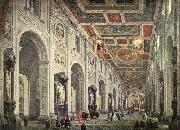Wholesale Oil Painting No Minimum |
|||||||||||
|
|
|||||||||||

|
|||||||||||
|
|
|
||||||||
PANNINI, Giovanni PaoloItalian Neoclassical Painter, ca.1691-1765 was an Italian painter and architect, mainly known as one of the vedutisti or (veduta, or "view painters"). As a young man, Pannini trained in his native town of Piacenza as a stage designer. In 1711, he moved to Rome, where he studied drawing with Benedetto Luti and became famous as a decorator of palaces, including the Villa Patrizi (1718C1725) and the Palazzo de Carolis (1720). As a painter, Pannini is best known for his vistas of Rome, in which he took a particular interest in the city's antiquities. Among his most famous works are the interior of the Pantheon, and his vedute paintings of picture galleries containing views of Rome. Most of his works, specially those of ruins have a substantial fanciful and unreal embellishment characteristic of capriccio themes. In 1719, Pannini was admitted to the Congregazione dei Virtuosi al Pantheon. He taught in Rome at the Accademia di San Luca and the Academie de France, where he influenced Jean-Honore Fragonard. His studio included Hubert Robert and his son Francesco Panini. His style would influence a number of other vedutisti, such as his pupil Antonio Joli, as well as Canaletto and Bernardo Bellotto, |
||||||||
|
|
||||||||
Interior of the San Giovanni in Laterano in Rome
Interior of the San Giovanni in Laterano in Rome Painting ID:: 63837 |
Oil on canvas, 74 x 100 cm Pushkin Museum, MoscowArtist:PANNINI, Giovanni Paolo Title: Interior of the San Giovanni in Laterano in Rome Painted in 1701-1750 , Italian - - painting : interior Oil on canvas, 74 x 100 cm Pushkin Museum, MoscowArtist:PANNINI, Giovanni Paolo Title: Interior of the San Giovanni in Laterano in Rome Painted in 1701-1750 , Italian - - painting : interior |
|||||||
|
|
||||||||
|
Giovanni Paolo Pannini 1691-1765 Italian Giovanni Paolo Pannini Galleries Italian painter. After gaining fame for his fresco painting, he specialized in Roman topography and became the foremost artist in that field in the 18th century. His real and imaginary views of ancient Roman ruins embody precise observation and tender nostalgia and combine elements of late classical Baroque art with incipient Romanticism. His work was popular both with tourists and his peers: he was admitted to the Acad??mie Française in 1732 and became its professor of perspective. Interior of the San Giovanni in Laterano in Rome Medium Oil on canvas Dimensions Expression error: Missing operand for *74 ?? 100 cm |
||||||||
|
|
||||||||
|
Prev Next
|
||||||||
|
|
||||||||
|
Related Paintings to Giovanni Paolo Pannini :. |
||||||||
|
|
||||||||
|
CONTACT US |

